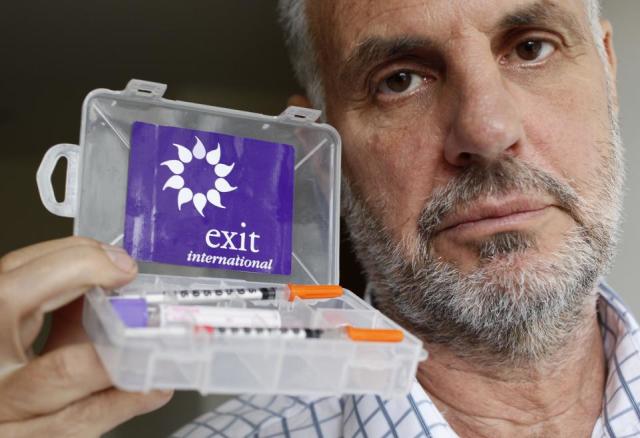https://www.yahoo.com/news/meet-elon-musk-assisted-suicide-130003176.html
Dr. Philip Nitschke considers himself the Elon Musk of assisted suicide — and his latest death machine, the Sarco, is his Tesla.
Newsweek spoke with the 70-year-old doctor immediately after the state of Victoria in Australia, his home country, voted this week to legalize euthanasia. Many are billing this as the first law of this nature down under, but Dr. Nitschke performed his first assisted death in 1996, during a brief period of legality in the country’s Northern Territory.
As a young medical school graduate, Nitschke found himself drawn to the world of euthanasia and the work of Dr. Jack Kevorkian, the most famous euthanasia proponent in the United States. Inspired by Kevorkian’s death machine, Nitschke set out to create an updated version that he dubbed “The Deliverance.” The machine was rudimentary, comprising only a laptop hooked to an IV system, but it worked. A computer program would confirm a patient’s intent to die and then trigger a lethal injection of barbiturates. It successfully ended four lives before Australia repealed the bill that legalized euthanization in 1997.
Trending: ‘War & Lesiure’: Top Songs on Miguel’s New Album
But ending legal euthanasia “didn’t stop people from coming to me saying that they wanted to die,” said Nitschke. “I’ve spent the last 20 years fighting for the legislation that just passed.”
Nitschke has aided in hundreds of what he calls “rational suicides.” In 1997 he founded Exit International, a nonprofit that advocates for the legalization of euthanasia, and in 2006 he published the Peaceful Pill Handbook, which instructs on the most painless and efficient ways to commit suicide.
All the while, Nitschke continued to innovate his death machine. He created his version of an “exit bag,” which acts as a bizzaro breathing mask, with carbon monoxide replacing oxygen. These bags are highly effective, but not very appealing, Nitschke said. He calls it the “plastic bag factor.” People don’t want to leave this world in such an aesthetically displeasing way, he explained.
His latest machine, The Sarco, is the answer to those aesthetic problems. The machine is sleek, and Nitschke stresses, luxurious. The finished product resembles a spaceship, intended to convince its user that he or she is journeying to the great beyond, he said. It consists of a base that contains canisters of liquid nitrogen and a removable capsule compartment, which can be repurposed as a casket. The whole operation will be open-source and could theoretically be 3D printed anywhere in the world. It is, in short, the Model S of death machines.
Don’t miss: Mass Hockey Fight Breaks Out at Russian Youth Tournament
Here’s how it works: Potential users fill out an online survey that tests mental fitness, and if they pass they receive an access code that works for 24 hours. After the code is entered and an additional confirmation is given, the Sarco capsule will fill up with liquid nitrogen to bring the oxygen level down to about 5 percent. Within one minute the user passes out, and a few minutes later, death comes.
Nitschke vows that the death is relatively painless — there is no asphyxiation and the user breathes easily, he said. He compares it to an airplane cabin depressurizing. The model is scheduled to become widely available next year, and Nitschke is already in talks with some suicide clinics in Switzerland to license the machine.
Fighting to Die
Over the past 20 years, the right to physician-assisted has been legalized in Washington, California, Vermont, Oregon and a several European countries. Nitschke believes that the change in attitude stems from the aging Baby Boomer generation. “I’ve seen a marked difference between generations,” he said. “Boomers want to be in control of their own deaths. They don’t like the idea of someone patting them on the head and telling them what to do.”
But each state and country has its own nuanced set of rules around medical aid-in-dying, while Nitschke believes the right to die is a human right, not a medical or legal privilege. No one should be subject to rules about whether or not a person is sick enough to choose to die, he said.
Most popular: As Obama Warns Modi, Ivanka Given Lavish Welcome in India
It is the “right of a rational adult to have a peaceful death,” he said. “Every person over the age of 70 should be able to die.”
Of course, not everyone agrees with Nitschke. “I think it’s bad medicine, ethics, and bad public policy,” Dr. Daniel Sulmasy, a Georgetown professor of biomedical ethics, told Newsweek. “It converts killing into a form of healing, and doesn’t acknowledge that we can now do more for symptoms through palliative than ever before.” Palliative care focuses on improving the quality of lives for people fighting deadly illnesses, rather than ending those lives.
Sulmasy believes assisted suicide violates the bedrock of all ethical thinking, which is that people have value simply by being human beings. He argues that assisted suicide sends a message to disabled and dying people that society believes they should choose death if they become too much of a burden.
He worries about the contagious effect that suicide often has, pointing to the rash of suicides that occurred after Derek Humphry published Final Exit, a book that detailed aspects of planning and carrying out suicide. After the book was published in 1991, the number of suicides by asphyxiation in New York City rose by 313 percent that year. Sulmasy also pointed out that in Holland, nearly 5 percent of all deaths are due to euthanasia or assisted suicide.
Doctors can ethically help patients find the ultimate relief in their final days ethically through a process called the rule of double effect, Sulmasy said. The rule says that if a patient agrees to the risks, an attending physician is allowed to keep increasing the dosage of pain medication until pain is completely under control, which may mean administering enough to render the patient unconscious or kill them.
Nitschke argues that palliative care isn’t for everybody. People in good health have approached him simply because they feel that they’ve had a good life and are ready to go, he said. He believes that they have just as much a right to death as anyone else.
The death doctor, now a septuagenarian himself, is also coming to terms with his own mortality. And his invention might be his solution.
“I’ve thought about it a lot lately,” he said. “I am attracted to the idea of the Sarco, and if I find myself in a situation where I need to use it I will.”







Why limit it to the terminally ill. It should be an option as well to those who have just had it with this shitty world and wish to go home. They want to keep us all here in their hell. It’s a basic human right which they have denied us.
If I were terminally ill I would certainly consider it.
But I rather suspect I’ll perish in battle defending someone / something / somewhere. And the attackers will know they were in a fight.
Unless, of course, some jealous boyfriend can out-draw me when I’m 90 ….